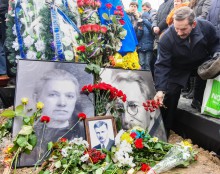At about 1 p.m. on January 29, participants of the funeral procession arrived at the Lukianivske Cemetery in the capital city. Remains of Oleksandr Oles were welcomed by the Ukrainian song Oh, the Red Viburnum in the Meadow, performed to the accompaniment of a brass band. The memorial service was attended by President Petro Poroshenko and his wife, numerous authors, historians, artists, journalists, politicians, and other active citizens and guests of the city. “In his works, the poet repeatedly conveyed the idea that it was internal strife and discord, inability to unite for a great purpose that repeatedly led to tragic turns of Ukrainian history,” Poroshenko remarked.
Let us recall that remains of the famous Ukrainian writer Oleksandr Oles (Kandyba) and his wife Vira, who had been buried in the Olsany Cemetery in Prague, were exhumed on January 3, 2017.
The poet’s reburial took place in Kyiv with all required honors and with the president and Ukrainian intellectuals in attendance. However, do Ukrainians know enough about the life and career of the writer? What is unique about his talent? Do people re-read his poetry? After all, are we willing to do that cultural “homework” which he assigned us?
Oleksandr Oles is known for extraordinarily refined and delicate lyric works, but he was at the same time a poet with the rare talent of historicism, and moreover, the gift of prophecy as well. At the beginning of the past century, he was hailed as “the Ukrainian Heinrich Heine” (by Khrystia Alchevska), “the greatest living Ukrainian poet” (by Mykhailo Hrushevsky) and even “the direct heir of Taras Shevchenko, equal in fiery enthusiasm and passionate love for the homeland” (by Sofia Rusova).

His first verse collection With Sadness a Joy Was Embracing..., published in St. Petersburg in 1907, brought the author considerable fame by itself. Even Lesia Ukrainka approvingly noted “that he outdid me as a lyric poet.” The poetry of Oleksandr Oles contains many still-important guidelines. His works “We Will Not Lay Down Our Arms...,” “Oh Our Word! You are the Bound Eagle!” and “Asters” are especially relevant...
As noted by the editor of Den’s “History and I” section Ihor Siundiukov in his article “A Tale of Joys and Torments,” creative legacy and career of Oleksandr Kandyba, who adopted pen name Oles, certainly ranked high in the pantheon of the highest achievements of the Ukrainian spirit in the 20th century. The prominent poet lived in forced exile in Prague for over 20 years at the end of his life and described it as a “tale of joys and torments.” He died on July 22, 1944, unable to endure the terrible grief brought him by the death of his beloved son, also highly talented poet Oleh Kandyba (Olzhych), who was tortured to death in the Sachsenhausen Nazi concentration camp. However, Oleksandr Oles ultimately returned to Ukraine, and not only as remains, but with his immortal poems as well, becoming the highest example of how to love one’s homeland in an era of cold indifference, and how to work with one’s word in an era of cynical barbarism.







